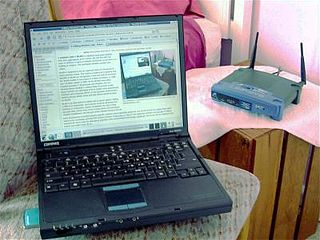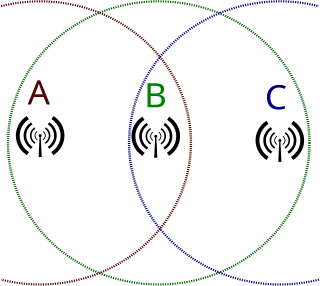
A wireless LAN (WLAN) is a wireless computer network that links two or more devices using wireless communication to form a local area network (LAN) within a limited area such as a home, school, computer laboratory, campus, office building etc. This gives users the ability to move around within the area and yet still be connected to the network. Through a gateway, a WLAN can also provide a connection to the wider Internet.

A wireless network is a computer network that uses wireless data connections between network nodes.

Carrier-sense multiple access with collision avoidance (CSMA/CA) in computer networking, is a network multiple access method in which carrier sensing is used, but nodes attempt to avoid collisions by beginning transmission only after the channel is sensed to be "idle". When they do transmit, nodes transmit their packet data in its entirety.

Network topology is the arrangement of the elements of a communication network. Network topology can be used to define or describe the arrangement of various types of telecommunication networks, including command and control radio networks, industrial fieldbusses and computer networks.
In telecommunications and computer networks, a channel access method or multiple access method allows more than two terminals connected to the same transmission medium to transmit over it and to share its capacity. Examples of shared physical media are wireless networks, bus networks, ring networks and point-to-point links operating in half-duplex mode.
The data link layer, or layer 2, is the second layer of the seven-layer OSI model of computer networking. This layer is the protocol layer that transfers data between adjacent network nodes in a wide area network (WAN) or between nodes on the same local area network (LAN) segment. The data link layer provides the functional and procedural means to transfer data between network entities and might provide the means to detect and possibly correct errors that may occur in the physical layer.

Zigbee is an IEEE 802.15.4-based specification for a suite of high-level communication protocols used to create personal area networks with small, low-power digital radios, such as for home automation, medical device data collection, and other low-power low-bandwidth needs, designed for small scale projects which need wireless connection. Hence, Zigbee is a low-power, low data rate, and close proximity wireless ad hoc network.
A collision domain is a network segment connected by a shared medium or through repeaters where simultaneous data transmissions collide with one another. The collision domain applies particularly in wireless networks, but also affected early versions of Ethernet. A network collision occurs when more than one device attempts to send a packet on a network segment at the same time. Members of a collision domain may be involved in collisions with one another. Devices outside the collision domain do not have collisions with those inside.

In IEEE 802 LAN/MAN standards, the medium access control sublayer is the layer that controls the hardware responsible for interaction with the wired, optical or wireless transmission medium. The MAC sublayer and the logical link control (LLC) sublayer together make up the data link layer. Within the data link layer, the LLC provides flow control and multiplexing for the logical link, while the MAC provides flow control and multiplexing for the transmission medium.
IEEE 802.11e-2005 or 802.11e is an approved amendment to the IEEE 802.11 standard that defines a set of quality of service (QoS) enhancements for wireless LAN applications through modifications to the media access control (MAC) layer. The standard is considered of critical importance for delay-sensitive applications, such as Voice over Wireless LAN and streaming multimedia. The amendment has been incorporated into the published IEEE 802.11-2007 standard.

In wireless networking, the hidden node problem or hidden terminal problem occurs when a node can communicate with a wireless access point (AP), but cannot directly communicate with other nodes that are communicating with that AP. This leads to difficulties in medium access control sublayer since multiple nodes can send data packets to the AP simultaneously, which creates interference at the AP resulting in neither packet getting through.
Over-the-Air programming (OTA) refers to various methods of distributing new software, configuration settings, and even updating encryption keys to devices like cellphones, set-top boxes or secure voice communication equipment. One important feature of OTA is that one central location can send an update to all the users, who are unable to refuse, defeat, or alter that update, and that the update applies immediately to everyone on the channel. A user could "refuse" OTA but the "channel manager" could also "kick them off" the channel automatically.

A mesh network is a local network topology in which the infrastructure nodes connect directly, dynamically and non-hierarchically to as many other nodes as possible and cooperate with one another to efficiently route data from/to clients. This lack of dependency on one node allows for every node to participate in the relay of information. Mesh networks dynamically self-organize and self-configure, which can reduce installation overhead. The ability to self-configure enables dynamic distribution of workloads, particularly in the event a few nodes should fail. This in turn contributes to fault-tolerance and reduced maintenance costs.
Point coordination function (PCF) is a media access control (MAC) technique used in IEEE 802.11 based WLANs, including Wi-Fi. It resides in a point coordinator also known as access point (AP), to coordinate the communication within the network. The AP waits for PIFS duration rather than DIFS duration to grasp the channel. PIFS is less than DIFS duration and hence the point coordinator always has the priority to access the channel.

Wireless security is the prevention of unauthorized access or damage to computers or data using wireless networks, which include Wi-Fi networks. The most common type is Wi-Fi security, which includes Wired Equivalent Privacy (WEP) and Wi-Fi Protected Access (WPA). WEP is a notoriously weak security standard: the password it uses can often be cracked in a few minutes with a basic laptop computer and widely available software tools. WEP is an old IEEE 802.11 standard from 1997, which was superseded in 2003 by WPA, or Wi-Fi Protected Access. WPA was a quick alternative to improve security over WEP. The current standard is WPA2; some hardware cannot support WPA2 without firmware upgrade or replacement. WPA2 uses an encryption device that encrypts the network with a 256-bit key; the longer key length improves security over WEP. Enterprises often enforce security using a certificate-based system to authenticate the connecting device, following the standard 802.1X.
A wireless ad hoc network (WANET) or Mobile ad hoc network (MANET) is a decentralised type of wireless network. The network is ad hoc because it does not rely on a pre-existing infrastructure, such as routers in wired networks or access points in managed (infrastructure) wireless networks. Instead, each node participates in routing by forwarding data for other nodes, so the determination of which nodes forward data is made dynamically on the basis of network connectivity and the routing algorithm in use.
A residential gateway is a small consumer-grade router which provides network access between local area network (LAN) hosts to a wide area network (WAN) via a modem. The modem may or may not be integrated into the hardware of the residential gateway. The WAN is a larger computer network, generally operated by an Internet service provider.
Reference Broadcast Time synchronization is a method in which the receiver uses the physical layer broadcasts for comparing the clocks. This is slightly different from traditional methods which synchronize the sender's with the receiver's clock.
MyriaNed is a wireless sensor network (WSN) platform developed by DevLab. It uses an epidemic communication style based on standard radio broadcasting. This approach reflects the way humans interact, which is called gossiping. Messages are sent periodically and received by adjoining neighbours. Each message is repeated and duplicated towards all nodes that span the network; it spreads like a virus.
IEEE 802.11ah is a wireless networking protocol published in 2017 to be called Wi-Fi HaLow as an amendment of the IEEE 802.11-2007 wireless networking standard. It uses 900 MHz license exempt bands to provide extended range Wi-Fi networks, compared to conventional Wi-Fi networks operating in the 2.4 GHz and 5 GHz bands. It also benefits from lower energy consumption, allowing the creation of large groups of stations or sensors that cooperate to share signals, supporting the concept of the Internet of Things (IoT). The protocol's low power consumption competes with Bluetooth and has the added benefit of higher data rates and wider coverage range.








